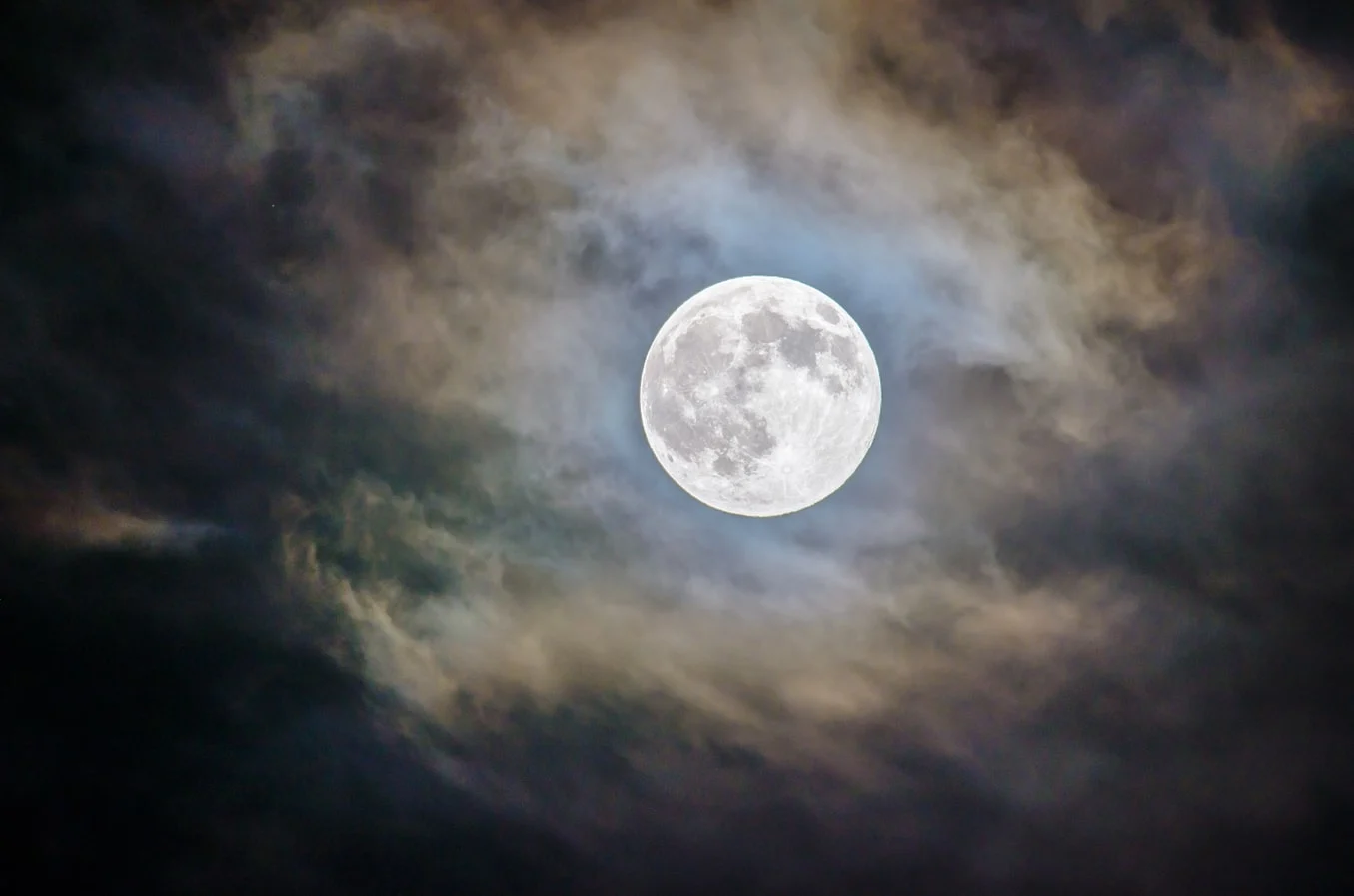
Eyes to the sky Friday night to see the Full Buck Moon
Ready for a treat? A Full Moon, two bright planets, and maybe even streaking meteors are putting on a show in the night sky.
July's Full Buck Moon rises as the Sun sets on Friday, but it won't be alone.
If your weather allows for it tonight, head outside to see the Full Moon, two bright planets, plus a possible bonus thanks to the Perseid Meteor Shower.
Read more: Why is the supermoon so compelling to us?
WHAT IS A 'BUCK' MOON?
According to NASA, the Maine Farmer's Almanac attributes the name 'Buck Moon' to the Algonquin peoples of the US Northeast.
"Early summer is normally when the new antlers of buck deer push out of their foreheads in coatings of velvety fur," they wrote. "They also called this the Thunder Moon because of early Summer's frequent thunderstorms."
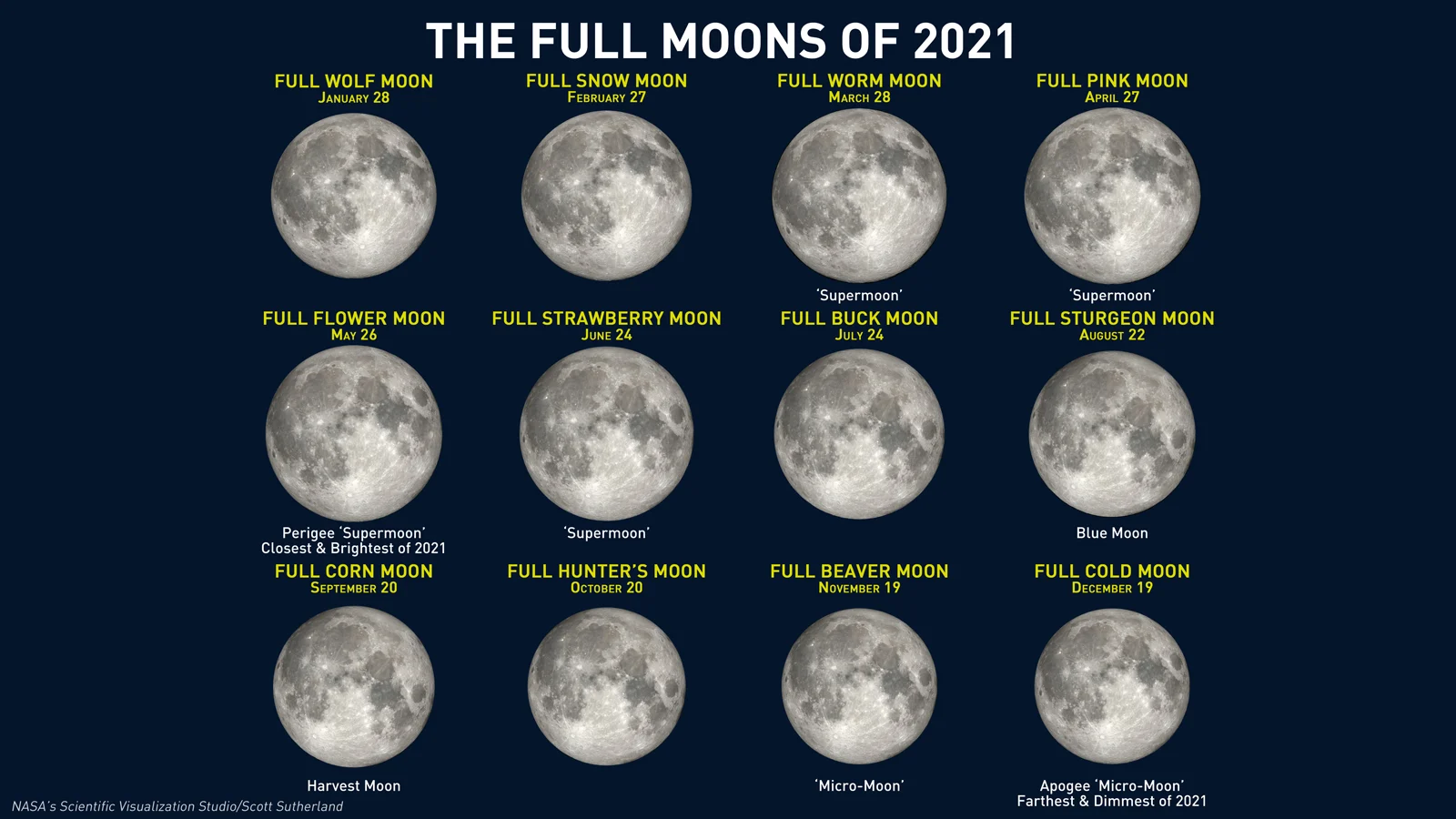
This graphic collects all the relevant data about each Full Moon of 2021, including their popular names, whether they are a 'super' or 'micro' Moon, a perigee or apogee Full Moon, and whether they are remarkable in some other way (Blue Moon or Harvest Moon). Credit: NASA's Scientific Visualization Studio/Scott Sutherland
In parts of Europe, the July Full Moon is also known as the Hay Moon or the Mead Moon. In India, Nepal, and Bhutan, those of the Hindu, Jain, and Buddhist religions call it the Guru Purnima (Guru Full Moon), which is a time to honour spiritual and academic gurus.
"For Theravada Buddhists," NASA says, "this full Moon is Asalha Puha, also known as Dharma Day or Esala Poya, an important festival celebrating Buddha's first sermon. As the full Moon day of Waso (the fourth month of the traditional Burmese lunisolar calendar), this is the start of the three-month annual Buddhist retreat called Vassa."
NOT ALONE IN THE SKY
This Full Buck Moon will not be alone as it crosses the night sky.

The July 23 Full Buck Moon has two bright companions in the sky. Credit: Stellarium/Scott Sutherland
When you look up at the Full Moon tonight, glance just to the left of it, and you will see two bright 'stars'. Depending on how much light pollution you have in your sky, these could be the only two stars visible (although the one closer to the Moon may be a bit more challenging to see). These two 'stars' are the largest planets in our solar system — Jupiter and Saturn. Each will reach their 'opposition' with Earth (being on the exact opposite side of Earth from the Sun) in August. However, they are still easily visible on most nights this summer.
Also, there's the potential for a special bonus to this view, as well. We are now one week into the annual Perseid Meteor Shower. Although we only see perhaps 10-20 meteors per hour from the Perseids at this time (so maybe 1 every 5 minutes or so), they can still be quite spectacular. They can even show up as very bright fireballs that streak across the night sky. Viewers far from city lights or have a suburban backyard sheltered from streetlights have a better chance of seeing these meteors. For best results, give yourself about 20 minutes to let your eyes adjust to the dark.
Watch below: Out of This World - Meteors and moons! Keep an eye on the sky this summer
FOUR FULL MOONS?
With each of our four seasons lasting roughly 3 months and typically one Full Moon per month, you could expect there to always be three Full Moons each season. However, our astronomical seasons don't line up perfectly with our calendar months. For example, Summer began on June 20, and it ends on September 22. So, technically, the overlap of a week or so at the start means that the season spans over 4 months. Thus if their timing is just right, you can see four Full Moons in one season.
It just so happens that 2021 is one of those years where this occurs. This first Full Moon of Summer is on June 24. Then, the following three Full Moons are on July 24, August 22, and September 20.
With four Full Moons this season, that means the third of those — on August 22 — is a Blue Moon. In this case, it's the Blue Sturgeon Moon (or 'Blue Corn Moon' if you follow some indigenous Moon lore).
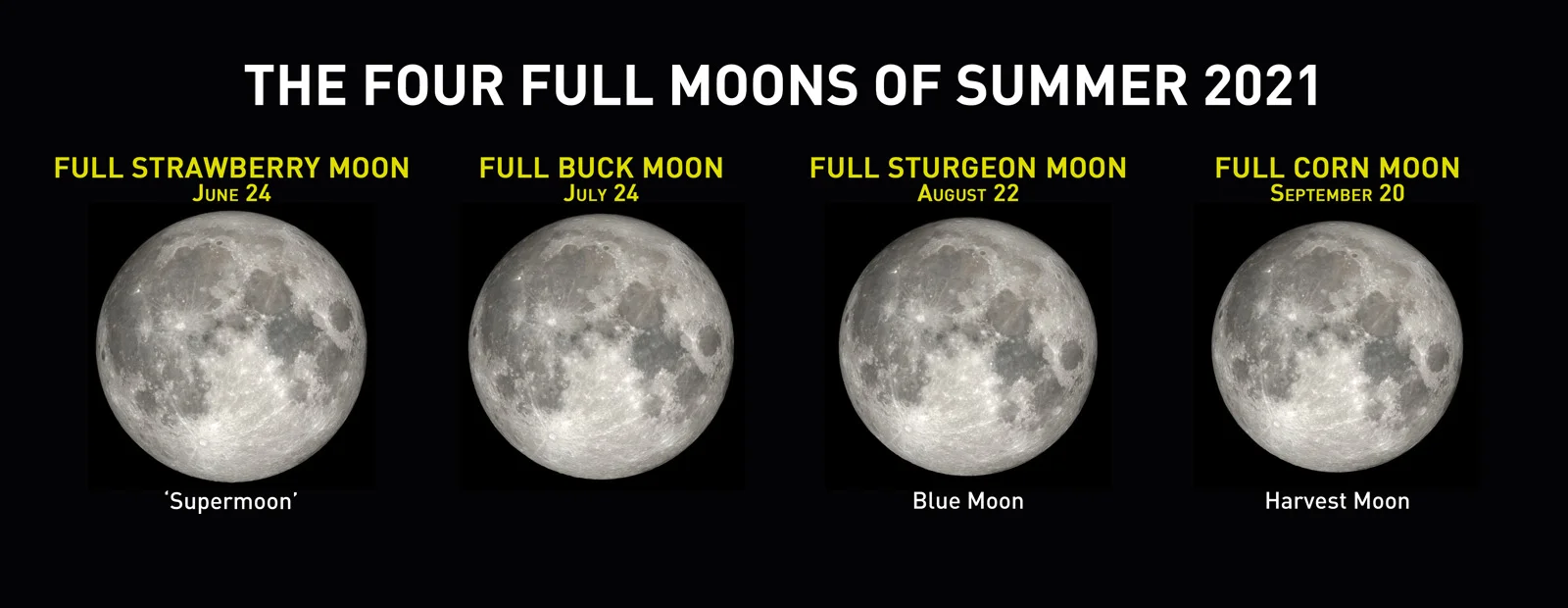
The four Full Moons of 2021. Credit: NASA's Scientific Visualization Studio/Scott Sutherland
A 'seasonal Blue Moon' occurs every few years. The last one was on May 18, 2019, when we saw four Full Moons in the spring of that year. The next seasonal Blue Moon, after this year, will be on August 19, 2024, when we will again see a summer with four Full Moons.
There's another kind of Blue Moon, by the way. Although it's not the original definition of Blue Moon, these days, we also apply that title to the second of two Full Moons that occur within the same calendar month. The last time we saw one of these was in October of 2020. The next time will be in August of 2023.
THE MADDENING MOON ILLUSION
Seeing the Full Moon at any time of night is a spectacular sight. However, go out just after moonrise or just before moonset for what is usually an exceptional treat. It's not something the Moon itself is doing, though. Instead, it's due to a bit of trick of our mind known as The Moon Illusion.
There are times when the Moon actually does look bigger to us, such as during a supermoon, when the Moon is physically thousands of kilometres closer to Earth than usual. There are other times, however, when we just think it looks larger.
As our eyes take in the world around us, our brain knows from experience that objects close to us tend to appear larger and in focus. In contrast, distant objects tend to be tiny and blurry. From this, it also knows that for a distant object to appear in focus, it must be very large.
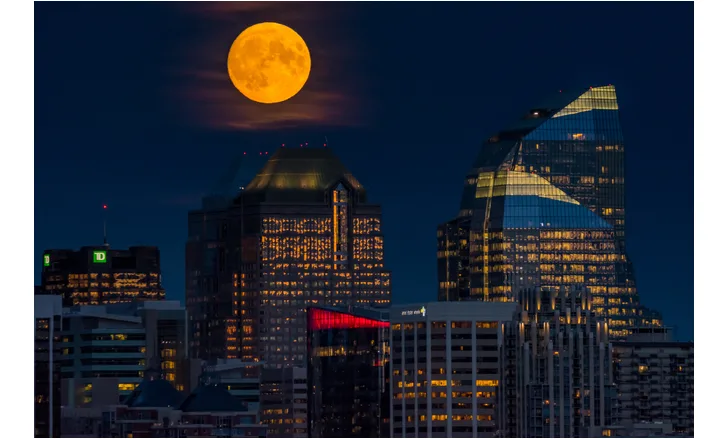
This close-up of the Harvest Moon was snapped in Calgary, AB, on September 13, 2019. Credit: Siv Heang
So, when we see a bright Full Moon hanging crisp and clear in the sky above the horizon, it is contrasted by all of the objects on the ground, which appear smaller and blurrier the closer they are to the horizon. This combination confuses the brain. To compensate, the brain interprets the Full Moon as being much bigger than it truly is. To be clear, the Moon is certainly much larger than any of the objects on the horizon (it's 3,474 km across), but this 'illusion' gives us the impression that the Moon looks enormous!
Look up into the sky closer to the middle of the night, and the Moon will be high above our heads. Usually, it will be the only thing we see, other than the stars and maybe a few planets. At that time, the brain is focused only on the Moon, and without the other objects in the field of view to complicate matters, it is free to just 'see' its actual size.
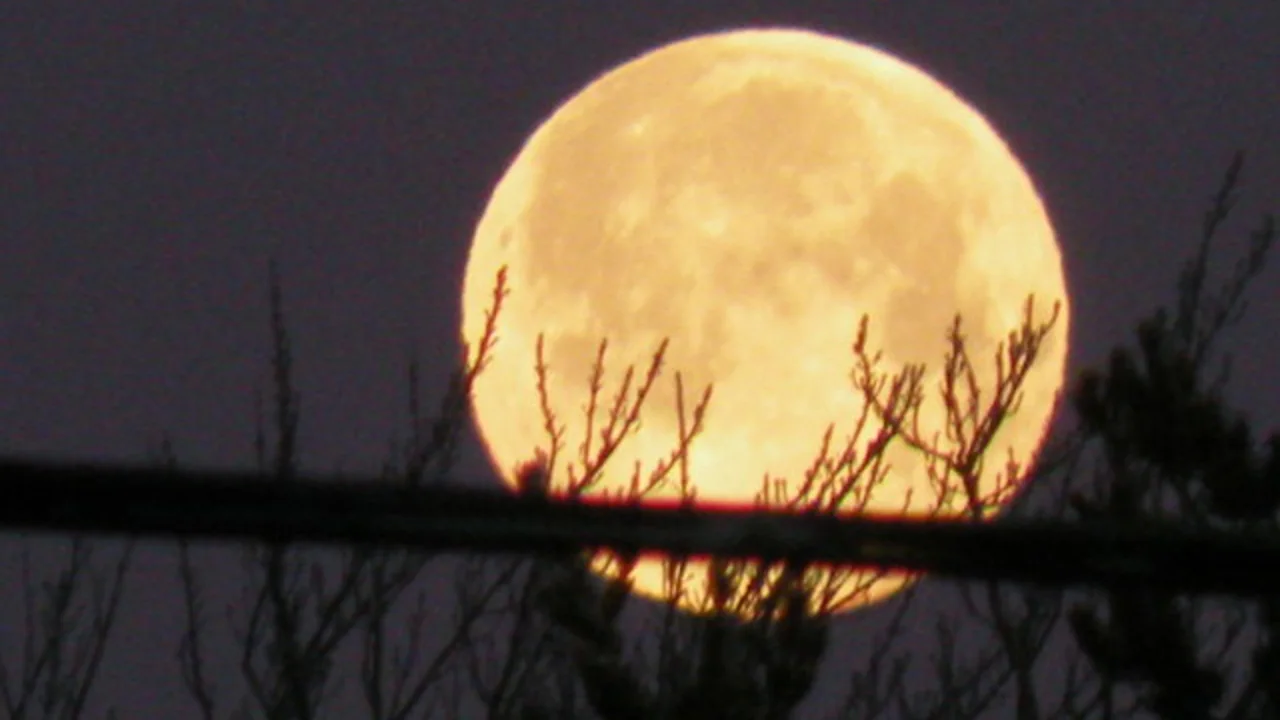
This zoomed-in image of the Full Snow Moon was captured from Salisbury, NB, on February 9, 2020, and uploaded into the Weather Network's UGC gallery. Credit: Darlene MacLeod/Smith
We have a few tricks of our own that can cancel out the Moon illusion, though.
For the first one, we don't need technology. Just go outside after sunset and find the Moon near the horizon. Stretch your arm out towards it, and cover the Moon over with your thumb or even your pinky finger. Note how big the Moon looks compared to the digit in question, and keep that in mind. Maybe even take a picture of it, if you want. Later in the night, check out the Moon again when it is high in the sky. It may appear smaller than when you saw it earlier, but repeat the step to cover it over with your thumb or finger. Compare it with what you saw before, and you'll find that the Moon is actually precisely the same size at both times.
There is a way technology can help us, though. When the Moon is low on the horizon, take out your cellphone, turn your camera on, and point it at the Moon. Note: it is possible for the Moon illusion to still work on us when looking at a picture or video. This is because the brain will make the same judgments of distance, blurriness, and size it did when looking at a 'live' scene. Still, directly comparing what we see in the sky at that time to what is shown on our small cellphone screen can help put things into better perspective. Plus, you can also take a few pictures to upload into the Weather Network UGC Gallery while you're at it!










